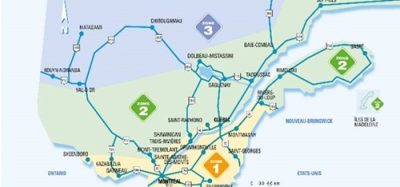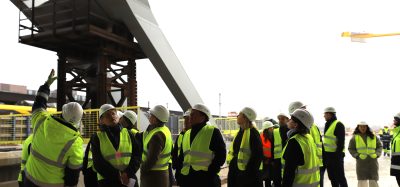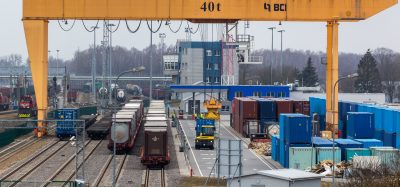A stronger European rail freight network
Posted: 3 December 2008 | | No comments yet
EWS, the British rail freight operator, is soon to start trading under the name of DB Schenker. Who? DB Schenker might be a new name to the rail market in Britain, but throughout the mainland European rail network it is a major global logistics player. DB Schenker is number one for rail freight transportation in Europe, and number one in land transportation in Europe. It is also the number two player in airfreight worldwide and number three in ocean freight worldwide.
EWS, the British rail freight operator, is soon to start trading under the name of DB Schenker. Who? DB Schenker might be a new name to the rail market in Britain, but throughout the mainland European rail network it is a major global logistics player. DB Schenker is number one for rail freight transportation in Europe, and number one in land transportation in Europe. It is also the number two player in airfreight worldwide and number three in ocean freight worldwide.
EWS, the British rail freight operator, is soon to start trading under the name of DB Schenker. Who? DB Schenker might be a new name to the rail market in Britain, but throughout the mainland European rail network it is a major global logistics player.
DB Schenker is number one for rail freight transportation in Europe, and number one in land transportation in Europe. It is also the number two player in airfreight worldwide and number three in ocean freight worldwide.
It has global revenues of €17.9 billion (April 2008) and employs over 88,000 people worldwide. Put simply, the transportation and logistics services delivered through DB Schenker reach every part of the world.
When EWS and Deutsche Bahn announced earlier last year that they were exploring ways of working closer together, the objective of both companies was to help facilitate the formation of a stronger European rail freight network. The strategic discussions built on the EWS success story in France.
EWS expanded into France with the creation of its subsidiary company Euro Cargo Rail, and its customers immediately benefited. Through EWS and Euro Cargo Rail, customers had two service providers owned by one company. Statistics show this approach has worked well, with Euro Cargo Rail having a 5% market share in France and over half of all traffic operated by the company has been won from road haulage.
The liberalisation of the rail freight market had enabled competition to be introduced across Europe, with operators being freed from geographic boundaries. This not only gives customers choice, but helps to improve performance and reliability. This in turn keeps costs low leading to growth as volumes are switched from road to rail.
During the discussions between EWS and Deutsche Bahn, it was obvious that in order to create a strong European rail freight network the best route was for EWS to be acquired by Deutsche Bahn.
This leads us to where this article began. EWS, lead by Chief Executive Keith Heller, will now trade under the name of DB Schenker as part of a successful global logistics company.
Also, by integrating and working closely with other partners within DB Schenker, a stronger European rail freight network is created. With the majority of rail freight customers in Britain trading with clients overseas, this stronger European rail freight network is in place to deliver for them.
As we enter 2009, the formation of this stronger European rail freight network is in place to deliver as the world enters an uncertain period. The global economic downturn will have an impact on total volumes moved by rail. In Britain, we have already seen temporary shutdowns at some steel plants and car manufacturers. It would be easy to say that this will lead to a decline in rail freight volumes.
However, as total freight volumes could decline during 2009/10, the objective of the railway across Europe to ensure that we continue to attract new volumes to rail through low costs, enhanced service delivery and innovation remains. This is where the creation of a stronger European rail freight network will deliver results. There is still significant growth in rail freight to be gained.
Look at the rail freight market in Britain. It handles over 120 millions tonnes of goods per annum, with growth rate of 70% in the last 12 years. This growth has been backed by over £1.5 billion of private sector investment in the rail freight industry.
The Government in Britain is also a strong backer of rail freight, expecting volumes to grow by 30% by 2014 and doubling in the longer term. This translates into a potential 240 million tonnes of freight transported on the rail network in Britain, representing a 20% share of surface land transportation. Similar growth is also forecast across Europe.
Other reasons for maintaining growth in rail freight is the contribution it makes to the Government’s economic, social and environmental goals. With rail freight emitting five times less CO2 per tonne kilometre moved than road haulage, the moment is now to for the railway across Europe to win additional volumes to rail. Increasing freight by rail is essential to mitigating the effects of climate change. Despite the economic downturn, climate change remains a key political issue to tackle.
Just look at the way that electrification has risen back up the railway agenda in Britain. This is seen as a possible way to reduce CO2 emissions.
However, there are wider benefits to the railway of further electrification than the obvious environmental case. From a rail freight viewpoint, the business case for electrification is enhanced through the gauge improvements required to electrify a rail route. This helps open up the railway to wider freight wagons enabling more goods to be moved per train.
An electrified railway would change how the long term railway would look in Britain, perhaps in the way that the end of steam changed the face of the railway in the 1960s. Electrification can be made to work for rail freight and we will support any work to achieve it.
Much of the electrification north of London follows the line of route on the West and East Coast Main Lines. A wider electrification programme could see routes such as the Midland Main Line and the Great Western routes electrified. Although freight trains rarely follow a line of route, instead moving from one route to another, electrification infill schemes provide links to the main electrified routes in the rail network.
DB Schenker has proposed 31 infill schemes to Network Rail that would enable a higher use of electric locomotive haulage by freight operators. DB Schenker suggests that while business cases and funding sources are made for complete line of route electrification where considered necessary, small infill electrification schemes should be considered, enabling the benefits of an expanded electrified network to be gained now.
Over the next three years, there is one highly visible construction project that will benefit from a stronger European rail freight network; the 2012 Olympic Games.
The construction phase of the next Olympic Games will be most sustainable ever, with at least 50% of all building materials being delivered to the building site by any mode of transport apart from road. With materials being sourced from across Europe, we have the opportunity to make this a construction project where rail was a major player.
DB Schenker is helping suppliers make deliveries to the construction site by rail through the Bow East Logistics Centre, centred between the South Plaza and the main Olympic Stadium in the Olympic Park.
This purpose built rail freight facility can supply virtually any product to the construction sites throughout the Olympic Park. The site, which opened in June 2008, currently manages the delivery and removal of thousands of tonnes of bulk aggregate products and waste to and from the Olympic Park every day.
The Bow East Logistics Centre can also handle multi-modal product shipments from sand and steel to cable reels, pallets and containers. Basically, if it can be shipped by rail, it can be delivered to the Olympic Park by rail.
The Olympic Delivery Authority’s sustainability policy specifies that 50% (by weight) of all products used in the construction of the Olympic Park venues should be delivered via a sustainable route. The Bow East Logistics Centre can accommodate rail freight haulage from anywhere in Europe.
There are also obviously key environmental and logistical advantages of using rail for delivery instead of road. The Bow East Logistics Centre is situated within the Olympic Park, fully staffed and operational now. With the typical inner London congestion around the Olympic Park and the added, essential, requirements of security screening, Bow East Logistics Centre will save hours, or even days, in your logistics chain. At the height of the Olympic project there will be approximately 400 vehicles a day trying to enter and leave the Olympic Park, a good reason to secure rail freight capacity now.
With the Olympic construction phase and continued growth projected for rail freight across Europe, our job is to continue delivering during the economic downturn. When the world economy recovers, success will be seen from a strong rail freight industry, which is backed by a stronger European rail freight network and one that continues to grow.






